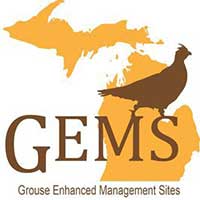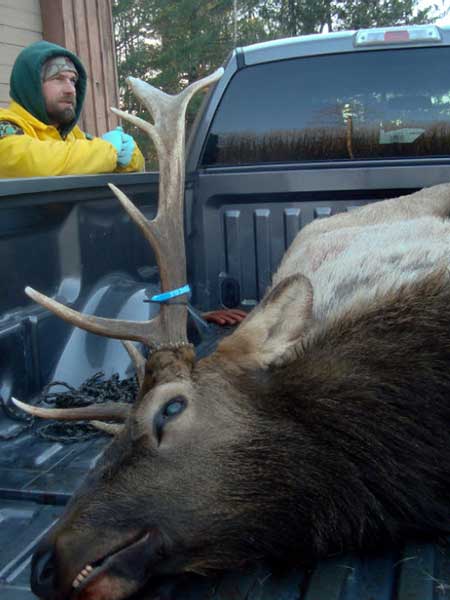- Details
(Provided by Michigan DNR)
 Grouse Enhanced Management Sites (GEMS)September brings many things, but for bird hunters, itís the month they've been waiting for since last year. Sept. 15 marks the opening day of ruffed grouse season in Michigan, the time when trucks hit public land two-tracks in search of prime hunting spots.
Grouse Enhanced Management Sites (GEMS)September brings many things, but for bird hunters, itís the month they've been waiting for since last year. Sept. 15 marks the opening day of ruffed grouse season in Michigan, the time when trucks hit public land two-tracks in search of prime hunting spots.
"Opening day of grouse season is a real treat - the woods are just coming alive with color, and you can smell fall in the air," said Department of Natural Resources upland game bird specialist Al Stewart. "With woodcock season opening on Sept. 19 this year, we have two openers only a few days apart! This is going to be a really exciting fall!"
The DNR and various partners have worked together to develop and maintain Grouse Enhanced Management Sites (GEMS) to give bird hunters places to target their hunt, help other hunters give bird hunting a try, and give seasoned hunters new locations to explore. GEMS are normally remote areas and vary in size from several hundred to several thousand acres. An intensive timber harvest schedule, closely monitored by DNR staff, helps to provide great wildlife habitat, and old logging roads are converted to walking trails that offer minimal terrain challenges and provide comfort to hunters who may not be familiar with the area.
"GEMS provide a unique experience for many people, including seniors and those with mobility challenges," said Eric Ellis, regional wildlife biologist with Ruffed Grouse Society and American Woodcock Society. "This year, we are providing financial support for the installation of kiosks at six GEMS locations.We also have successfully acquired grant funding and allocated Drummer Funds to further improve wildlife habitat at numerous GEMS locations."
- Details
(Provided by Michigan DNR)
 DNR technician Mark Monroe talks with a successful elk hunter at a check station.Michigan's 2014 elk hunting season just ended with multiple successes. Hunters experienced a one-of-a-kind hunt and filled the freezer with local meat, while also helping to accomplish valuable elk management on both public and private land.
DNR technician Mark Monroe talks with a successful elk hunter at a check station.Michigan's 2014 elk hunting season just ended with multiple successes. Hunters experienced a one-of-a-kind hunt and filled the freezer with local meat, while also helping to accomplish valuable elk management on both public and private land.
"The elk hunt is an exciting time for everyone," said DNR wildlife biologist Jennifer Kleitch. "We control the elk population through very intense management - we target specific areas and properties during certain time periods."
The elk season had two hunt periods - the early season, Aug. 26-29, Sept. 12-15 and Sept. 26-29 and the late season, Dec. 6-14. Just fewer than 30,000 eligible Michigan hunters applied for 100 elk licenses. Both the early and late season had quotas of 15 any-elk or bull licenses and 35 antlerless licenses.
Hunters during the early season harvested 37 elk - 13 bulls, 23 cows and 1 calf, while late-season hunters harvested 41 elk - 14 bulls and 27 cows.
"Again we had a good season, hunters were successful and safe, and we achieved our management goals," said Kleitch. "Not to mention the communities in the area feel the influx of the hunters with their families and the additional activity, so it really is a great season for the region."
- Details
The Indiana mourning dove season will expand by 18 days for the 2014-15 hunting season.
To accommodate these additional days, the DNR Division of Fish & Wildlife has added a third period for dove hunting, in December and January. Additionally, the DNR extended the first period, and modified the second period to avoid the firearms deer season.
The 2014-15 mourning dove hunting season is:
- Sep. 1 Oct. 19
- Nov. 1 Nov. 9
- Dec. 13 Jan. 11
Hunting hours are from one-half hour before sunrise until sunset. The daily bag limit is 15 with a possession limit of 45.
Most mourning doves are harvested in September, but great dove hunting can be found later in the season with a little scouting, said Budd Veverka, DNR farmland game research biologist. Looking at data from the past five years, I would expect to see approximately 11,000 dove hunters harvest nearly 214,000 mourning doves in 2014. With the extended season, the harvest could be even higher.
The expansion is based on research by the Indiana DNR and U.S. Fish & Wildlife Service.
- Details
The 2014-2015 Indiana fall hunting season has arrived.
Indiana's squirrel season runs Aug. 15 through Jan. 31. Hunters may harvest both gray and fox squirrels, and can harvest up to five squirrels per day.
Indiana's abundant squirrel populations offer great hunting, and squirrel season can be an opportunity to introduce beginners to hunting.
- Details
(Provided by Michigan DNR)
The Michigan DNR reminds woodcock hunters to add a free woodcock stamp to their base license this year.
The free woodcock stamp automatically registers woodcock hunters with the Migratory Bird Harvest Information Program (HIP). These HIP records are vital for the management of American woodcock and are used to estimate harvest and days spent afield.




